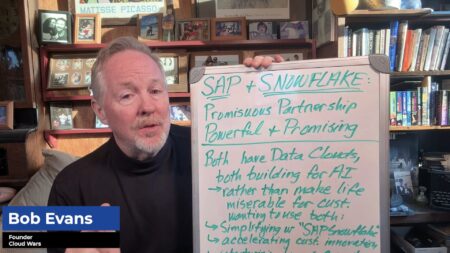Customers and revenue are the air and water of business. But how customers buy, sellers sell, and revenue is generated are in a state of flux. Sweeping market changes are challenging traditional buyer-seller relationships. And companies are scrambling to figure out the right Sales-Marketing relationship to maximize revenue generation.
Efforts to “align” B2B Sales and Marketing are not new, but this meandering quest has become a critical priority. The traditional Sales-Marketing relationship where work is divided between the two departments, then cobbled back together, is not working. The reason? B2B professionals want to control their purchase process by selecting vendors who are responsive to their needs.
Progressive business and revenue leaders are responding by integrating Sales and Marketing into unified buyer-led, data-driven strategies, breaking down legacy silos, and removing friction from the buyer-seller process.
So, what are the accelerators of an impactful Sales-Marketing partnership? An integrated revenue partnership relies on data and artificial intelligence (AI) for more targeted prospecting and customer communications. The partnership requires a unified go-to-market strategy based on clearly defined roles, documented processes and playbooks, and a well-defined lead-to-revenue process. And, most importantly, a successful Sales-Marketing partnership is fueled by shared performance metrics and reward systems driving desired outcomes.
Best Account Opportunities and Ideal Customer Profiles
Mastering a Sales-Marketing integrated revenue strategy starts with looking externally to map how your prospects and customers research, buy, and work with companies like yours. A common misstep is to target accounts that Sales and/or the CXO leaders want to become customers. This “internally curated” list can look mysteriously like the Fortune 100 (sarcasm intended). To engage and win these accounts, Marketing and Sales must focus lots of resources on the list, only to discover most are not ready to buy or need their specific solutions.
The smarter approach is for Sales and Marketing to collaborate on developing target accounts using data to identify both in-market accounts, those researching solutions that your company offers, and out-of-market Ideal Customer Profiles (ICP), which are accounts that match your criteria but may not be in a buying cycle right now.
This coordinated effort provides more precise identification of the best fit accounts and prioritizes in-market accounts. Modern revenue teams are turning to AI and data-driven strategies, processes, and technologies. Examples include:
- Using intent signals to listen for in-market accounts that are researching solutions that match your companies’ products.
- Using propensity models to identify organizations that best fit existing company products or solutions, i.e. Ideal Customer Profiles.
- Using buyer behavioral data-capture and enrichment tools to inform buyer and account strategies.
This data-focused approach reduces the time and resources Marketing spends generating large volumes of leads that rarely convert to customers. This approach also informs which accounts and buyers Sales should prioritize. And, just as important, this approach delivers a more optimized experience for the buyers and accounts most likely to benefit from the solutions. Win. Win. Win.
High-Performance B2B Sales & Marketing Lead-to-Revenue Process
With both proactive account identification and buyer listening capabilities in place, Marketing and Sales can establish a unified lead-to-revenue process across in-market and ICP accounts. This co-developed strategy defines and governs the entire buyer-seller effort. Think of this effort as the company framework, infrastructure, and processes to generate revenue. It’s important to highlight that the process does not rely solely on technology and machines. Rather, AI-, data-, and automation-driven processes are combined with human intelligence and creativity throughout the revenue generation process.
Let’s break down the core components required to turn prospects into satisfied customers.
- Clear roles for Sales and Marketing: This effort defines which team member(s)/function(s) does what, when, what happens next, and how the teams collaborate throughout the buying-selling process. While an integrated strategy is essential, it is also important for Marketing and Sales to use their respective strengths. For example, Marketing should create and drive communications and programs to educate ICP accounts and buyers. Sales should be the primary outreach to accounts and decision-making teams who are in-market now.
- Efficient lead and data workflow process: As leads are generated, this process defines how leads are scored, prioritized, and how leads are routed for follow-up. It also defines what should happen next, including the talking points and content used in communications. Account and buyer intelligence are added to leads using first- and third-party data sources to meet customers’ needs. This layer of data intelligence infused in the workflow also helps inform the next best actions.
- Engaging, timely go-to-market “plays” and “programs”: To engage buyers and accounts in the buying and selling process, well-designed plays and programs are created to route the right buying stage. Programs are “always-on,” educating the market via high-value content while listening for account buying signals. Once engaged, the plays include information and content recommendations activated with specific outreach based on buyer and account behavior. This is where data meets creativity, and machines and humans work together.
- Personalized accounts and buyer experiences: Experiences are also the result of effective plays and programs. Done well, this is described as “delivering the right information at the right time to the right buyers at the right accounts.” This requires data about the person and their company to anticipate and predict what information the buyer needs. Buyers also report the best experiences are authentic, frictionless, simple, and even surprisingly delightful.
- Agile technology and data infrastructure to manage the entire process: Instead of having separate sales and marketing systems, the team creates a single, integrated infrastructure that support all stakeholders through the customer lifecycle. This integrated mindset also applies to the Operations team supporting, managing, and optimizing the entire process. Many organizations are integrating Sales Operations and Marketing Operations into a united group dubbed “Revenue Operations” with accountability during the entire revenue generation process.
Shared Goals, Performance Metrics, and Reward Systems to Drive New Behaviors
Like many change management initiatives, executives must expand beyond tech, data, and processes to focus on shifting the team’s mindset and behaviors. For Sales and Marketing, this starts with establishing and rewarding performance based on achieving shared goals. Sales cannot have one set of objectives and measurements, while Marketing operates with a different set.
Shared goals and performance metrics must be co-created, agreed to, and reviewed regularly with all stakeholders. The people and the impactful work must be celebrated and highlighted to promote continuous improvement and innovation. Finally, all Sales and Marketing stakeholders must have skin in the game. This means Sales and Marketing Objectives and Key Results (OKRs) and compensation should be set and measured based on company revenue performance and outcomes (versus by Marketing results and Sales results, separately).
The excellent news is when you are responsible for creating and maintaining the air and water of the business, the opportunity for impact is huge. Now is the time to work across Sales and Marketing leadership to make a meaningful impact.









